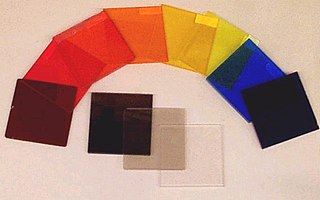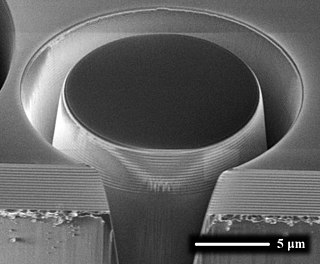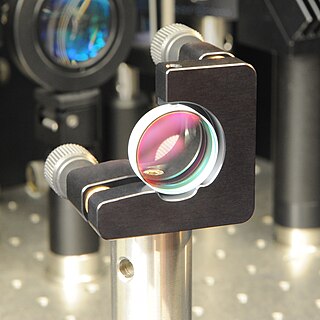Filter, filtering or filters may refer to:

An interference filter or dichroic filter is an optical filter that reflects one or more spectral bands or lines and transmits others, while maintaining a nearly zero coefficient of absorption for all wavelengths of interest. An interference filter may be high-pass, low-pass, bandpass, or band-rejection.

In optics, a dichroic material is either one which causes visible light to be split up into distinct beams of different wavelengths (colours), or one in which light rays having different polarizations are absorbed by different amounts.

Infrared cut-off filters, sometimes called IR filters or heat-absorbing filters, are designed to reflect or block mid-infrared wavelengths while passing visible light. They are often used in devices with bright incandescent light bulbs to prevent unwanted heating. There are also filters which are used in solid state video cameras to block IR due to the high sensitivity of many camera sensors to near-infrared light. These filters typically have a blue hue to them as they also sometimes block some of the light from the longer red wavelengths.

Thin-film optics is the branch of optics that deals with very thin structured layers of different materials. In order to exhibit thin-film optics, the thickness of the layers of material must be on the order of the wavelengths of visible light. Layers at this scale can have remarkable reflective properties due to light wave interference and the difference in refractive index between the layers, the air, and the substrate. These effects alter the way the optic reflects and transmits light. This effect, known as thin-film interference, is observable in soap bubbles and oil slicks.

H-alpha (Hα) is a specific deep-red visible spectral line in the Balmer series with a wavelength of 656.28 nm in air; it occurs when a hydrogen electron falls from its third to second lowest energy level. H-alpha light is important to astronomers as it is emitted by many emission nebulae and can be used to observe features in the Sun's atmosphere, including solar prominences and the chromosphere.

A beam splitter is an optical device that splits a beam of light in two. It is the crucial part of most interferometers.

A dichroic prism is a prism that splits light into two beams of differing wavelength (colour). A trichroic prism assembly combines two dichroic prisms to split an image into 3 colours, typically as red, green and blue of the RGB colour model. They are usually constructed of one or more glass prisms with dichroic optical coatings that selectively reflect or transmit light depending on the light's wavelength. That is, certain surfaces within the prism act as dichroic filters. These are used as beam splitters in many optical instruments.

An optical coating is one or more thin layers of material deposited on an optical component such as a lens or mirror, which alters the way in which the optic reflects and transmits light. One type of optical coating is an antireflection coating, which reduces unwanted reflections from surfaces, and is commonly used on spectacle and photographic lenses. Another type is the high-reflector coating which can be used to produce mirrors which reflect greater than 99.99% of the light which falls on them. More complex optical coatings exhibit high reflection over some range of wavelengths, and anti-reflection over another range, allowing the production of dichroic thin-film optical filters.

An optical filter is a device that selectively transmits light of different wavelengths, usually implemented as a glass plane or plastic device in the optical path, which are either dyed in the bulk or have interference coatings. The optical properties of filters are completely described by their frequency response, which specifies how the magnitude and phase of each frequency component of an incoming signal is modified by the filter.

In infrared photography, the film or image sensor used is sensitive to infrared light. The part of the spectrum used is referred to as near-infrared to distinguish it from far-infrared, which is the domain of thermal imaging. Wavelengths used for photography range from about 700 nm to about 900 nm. Film is usually sensitive to visible light too, so an infrared-passing filter is used; this lets infrared (IR) light pass through to the camera, but blocks all or most of the visible light spectrum.

The NASA Infrared Telescope Facility is a 3-meter (9.8 ft) telescope optimized for use in infrared astronomy and located at the Mauna Kea Observatory in Hawaii. It was first built to support the Voyager missions and is now the US national facility for infrared astronomy, providing continued support to planetary, solar neighborhood, and deep space applications. The IRTF is operated by the University of Hawaii under a cooperative agreement with NASA. According to the IRTF's time allocation rules, at least 50% of the observing time is devoted to planetary science.

A hot mirror is a specialized dielectric mirror, a dichroic filter, often employed to protect optical systems by reflecting infrared light back into a light source, while allowing visible light to pass. Hot mirrors can be designed to be inserted into the optical system at an incidence angle varying between zero and 45 degrees, and are useful in a variety of applications where the buildup of waste heat can damage components or adversely affect spectral characteristics of the illumination source. Wavelengths reflected by an infrared hot mirror range from about 750 to 1250 nanometers. By transmitting visible light wavelengths while reflecting infrared, hot mirrors can also serve as dichromatic beam splitters for specialized applications in fluorescence microscopy or optical eye tracking.

A chirped mirror is a dielectric mirror with chirped spaces—spaces of varying depth designed to reflect varying wavelengths of lights—between the dielectric layers (stack).

Dichroic glass is glass which displays two different colors by undergoing a color change in certain lighting conditions.
Wood's glass is an optical filter glass invented in 1903 by American physicist Robert Williams Wood (1868–1955), which allows ultraviolet and infrared light to pass through, while blocking most visible light.
Ultraviolet photography is a photographic process of recording images by using light from the ultraviolet (UV) spectrum only. Images taken with ultraviolet light serve a number of scientific, medical or artistic purposes. Images may reveal deterioration of art works or structures not apparent under visible light. Diagnostic medial images may be used to detect certain skin disorders or as evidence of injury. Some animals, particularly insects, use ultraviolet wavelengths for vision; ultraviolet photography can help investigate the markings of plants that attract insects, while invisible to the unaided human eye. Ultraviolet photography of archaeological sites may reveal artifacts or traffic patterns not otherwise visible.

An output coupler (OC) is the component of an optical resonator that allows the extraction of a portion of the light from the laser's intracavity beam. An output coupler most often consists of a partially reflective mirror, allowing a certain portion of the intracavity beam to transmit through. Other methods include the use of almost-totally reflective mirrors at each end of the cavity, emitting the beam either by focusing it into a small hole drilled in the center of one mirror, or by redirecting through the use of rotating mirrors, prisms, or other optical devices, causing the beam to bypass one of the end mirrors at a given time.
















